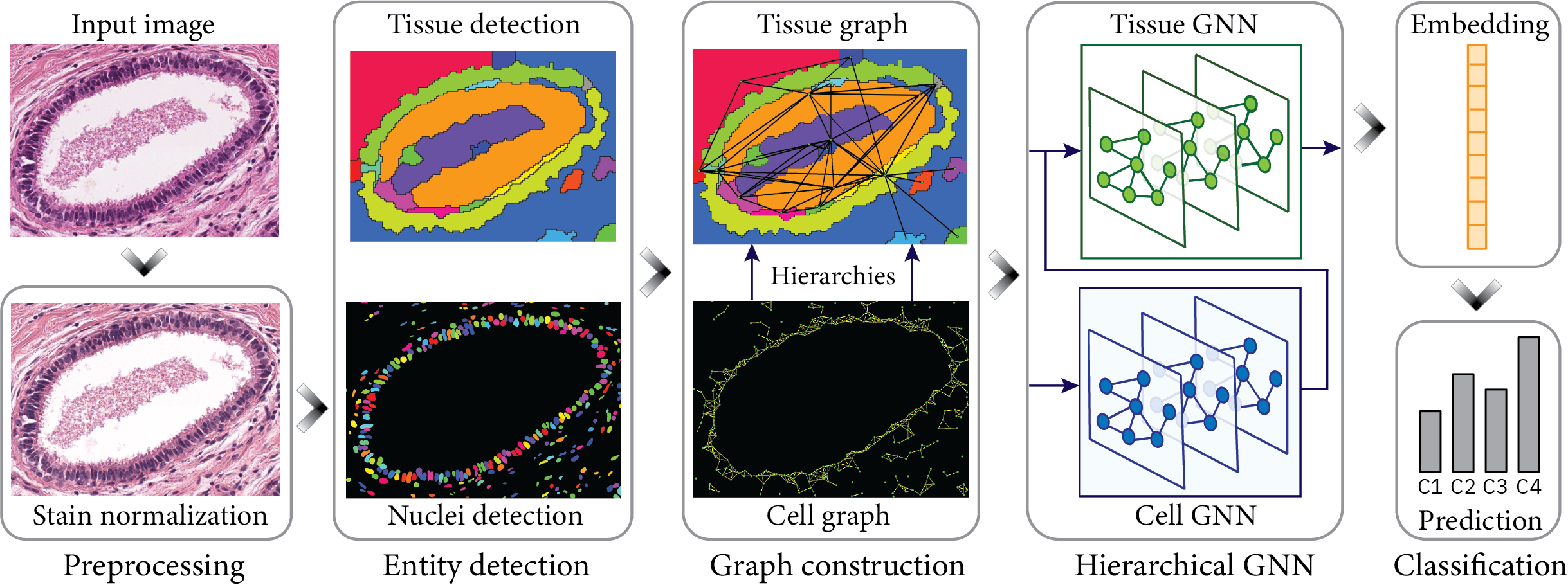This repository contains the code to reproduce results of the Hierarchical Graph Representations in Digital Pathology paper.
The code mostly relies on the histocartography library, a python-based package for modeling and learning with graphs of pathology images.
All the experiments are based on the BRACS dataset. The data needs to be downloaded separately (see Installation steps).
Clone the repo:
git clone https://github.com/histocartography/hact-net.git && cd hact-net
Create a conda environment and activate it:
conda env create -f environment.yml
conda activate hactnet
BRACS is a dataset of Hematoxylin and Eosin (H&E) histopathological images for automated detection/classification of breast tumors. BRACS includes >4k tumor regions-of-interest labeled in 7 categories (Normal, Benign, UDH, ADH, FEA, DCIS, Invasive).
In order to download the BRACS dataset, you need to create an account there. Then, go to Data Collection, Download, and hit the Regions of Interest Set button to access the data. Download the previous_version data. The data are stored on an FTP server.
The proposed HACT-Net architecture operates on a HieArchical Cell-to-Tissue representation that is further processed by a Graph Neural Network. Running HACT-Net requires 2 steps:
The HACT representation can be generated for the train set by running:
cd core
python generate_hact_graphs.py --image_path <PATH-TO-BRACS>/BRACS/train/ --save_path <SOME-SAVE-PATH>/hact-net-data
For generating HACT on the test and val set, simply replace the image_path by <PATH-TO-BRACS>/BRACS/val/ or <PATH-TO-BRACS>/BRACS/test/.
The script will automatically create three directories containing for each image:
- a cell graph as a
.binfile - a tissue graph as a
.binfile - an assignment matrix as an
.h5file
After the generation of HACT graphs on the whole BRACS set, the hact-net-data dir should look like:
hact-net-data
|
|__ cell_graphs
|
|__ train
|
|__ test
|
|__ val
|
|__ tissue_graphs
|
|__ train
|
|__ test
|
|__ val
|
|__ assignment_matrices
|
|__ train
|
|__ test
|
|__ val
We provide the option to train 3 types of models, namely a Cell Graph model, Tissue Graph model and HACTNet model.
Training HACTNet as:
python train.py --cg_path <SOME-SAVE-PATH>/hact-net-data/cell_graphs/ --tg_path <SOME-SAVE-PATH>/hact-net-data/tissue_graphs/ --assign_mat_path <SOME-SAVE-PATH>/hact-net-data/assignment_matrices/ --config_fpath ../data/config/hact_bracs_hactnet_7_classes_pna.yml -b 8 --in_ram --epochs 60 -l 0.0005
Training a Cell Graph model as:
python train.py --cg_path <SOME-SAVE-PATH>/hact-net-data/cell_graphs/ --config_fpath ../data/config/cg_bracs_cggnn_7_classes_pna.yml -b 8 --in_ram --epochs 60 -l 0.0005
Training a Tissue Graph model as:
python train.py --tg_path <SOME-SAVE-PATH>/hact-net-data/tissue_graphs/ --config_fpath ../data/config/tg_bracs_tggnn_7_classes_pna.yml -b 8 --in_ram --epochs 60 -l 0.0005
Usage is:
usage: train.py [-h] [--cg_path CG_PATH] [--tg_path TG_PATH]
[--assign_mat_path ASSIGN_MAT_PATH] [-conf CONFIG_FPATH]
[--model_path MODEL_PATH] [--in_ram] [-b BATCH_SIZE]
[--epochs EPOCHS] [-l LEARNING_RATE] [--out_path OUT_PATH]
[--logger LOGGER]
optional arguments:
-h, --help show this help message and exit
--cg_path CG_PATH path to the cell graphs.
--tg_path TG_PATH path to tissue graphs.
--assign_mat_path ASSIGN_MAT_PATH
path to the assignment matrices.
-conf CONFIG_FPATH, --config_fpath CONFIG_FPATH
path to the config file.
--model_path MODEL_PATH
path to where the model is saved.
--in_ram if the data should be stored in RAM.
-b BATCH_SIZE, --batch_size BATCH_SIZE
batch size.
--epochs EPOCHS epochs.
-l LEARNING_RATE, --learning_rate LEARNING_RATE
learning rate.
--out_path OUT_PATH path to where the output data are saved (currently
only for the interpretability).
--logger LOGGER Logger type. Options are "mlflow" or "none"
The output of this script will be a directory containing three models corresponding to the best validation loss, validation accuracy and weighted F1-score.
We also provide a script for running inference with the option to use a pretrained model.
For instance, running inference with a pretrained HACTNet model:
python inference.py --cg_path <SOME-SAVE-PATH>/hact-net-data/cell_graphs/ --tg_path <SOME-SAVE-PATH>/hact-net-data/tissue_graphs/ --assign_mat_path <SOME-SAVE-PATH>/hact-net-data/assignment_matrices/ --config_fpath ../data/config/hact_bracs_hactnet_7_classes_pna.yml --pretrained
We provide 3 pretrained checkpoints performing as:
| Model | Accuracy | Weighted F1-score |
|---|---|---|
| Cell Graph Model | 58.1 | 56.7 |
| Tissue Graph Model | 58.6 | 57.8 |
| HACTNet Model | 61.7 | 61.5 |
If you use this code, please consider citing our work:
@inproceedings{pati2021,
title = "Hierarchical Graph Representations in Digital Pathology",
author = "Pushpak Pati, Guillaume Jaume, Antonio Foncubierta, Florinda Feroce, Anna Maria Anniciello, Giosuè Scognamiglio, Nadia Brancati, Maryse Fiche, Estelle Dubruc, Daniel Riccio, Maurizio Di Bonito, Giuseppe De Pietro, Gerardo Botti, Jean-Philippe Thiran, Maria Frucci, Orcun Goksel, Maria Gabrani",
booktitle = "arXiv",
url = "https://arxiv.org/abs/2102.11057",
year = "2021"
}
